May 2022 Invasive Plant of the Month
SICIM Email
Mugwort (Artemisia vulgaris)
Mugwort, Artemisia vulgaris, is a perennial plant that has spread throughout North America but is most commonly found in the eastern US and Canada. Originally from Europe and eastern Asia, it may have arrived in ballast soils of ships as early as the 16th century. Mugwort commonly invades degraded areas such as old fields, roadsides, parking lots, forest edges and ditches, and spreads aggressively primarily by rhizomes. It is one of the 44 species listed in the Indiana Terrestrial Plant Rule, prohibiting its sale and distribution, and is considered an invasive species in many states. Mugwort has a long history of being used as a medicinal and culinary herb, and contributes significantly to hay fever symptoms in areas where it is abundant.
IDENTIFICATION & BIOLOGY: A member of the Aster family, mugwort is an herbaceous perennial with branched, purplish-brown stems and grows to a height of 2-5 ft. Ascending stems are covered with short hairs. The root system is extensive though shallow (to 20 cm in depth), with many branching rhizomes up to 1 cm in diameter. Research has shown that plants can regenerate from rhizome fragments as small as 2 cm and possibly smaller. Leaves: Leaf shape can vary depending on the maturity and location of leaves on the plant. Mugwort has simple, lobed leaves that are papery and dark green on the upper surface and gray underneath with silvery-white hairs. Leaves near the base are elliptic and oblong, lobed deeply almost to the midrib; leaves midstem are elliptic to ovate, 1.2-4 in long by 0.6-2.4 in wide and lobed pinnately or bipinnately. Leaves are alternate and margins may be serrated. Leaves emit a spicy scent when crushed. Flowers: Flowers are inconspicuous clusters at the top of the plant containing disk flowers only (lacking petals), and bloom in late summer to early fall. Color changes from white/green to purplish as the season advances. Fruits: Many small obovate or ovate achenes (one-seeded fruits containing a single seed) develop and mature from August to October. Seeds are wind dispersed and a single plant can produce a large amount of seeds, but some biotypes do not produce viable seed.
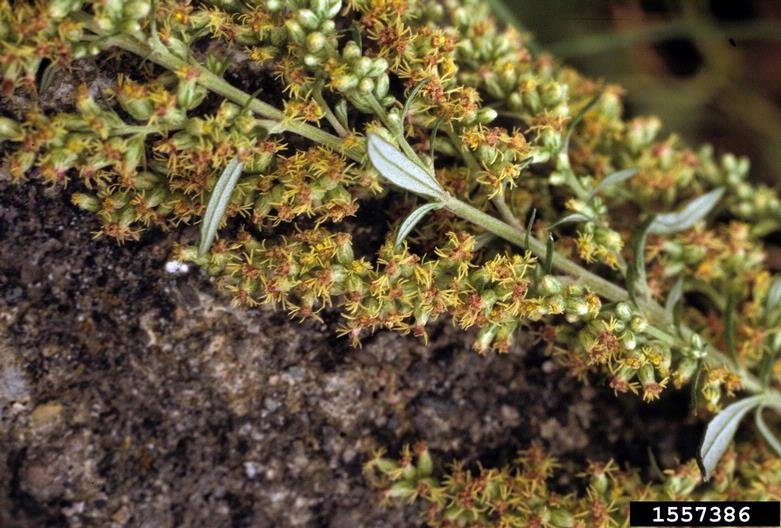
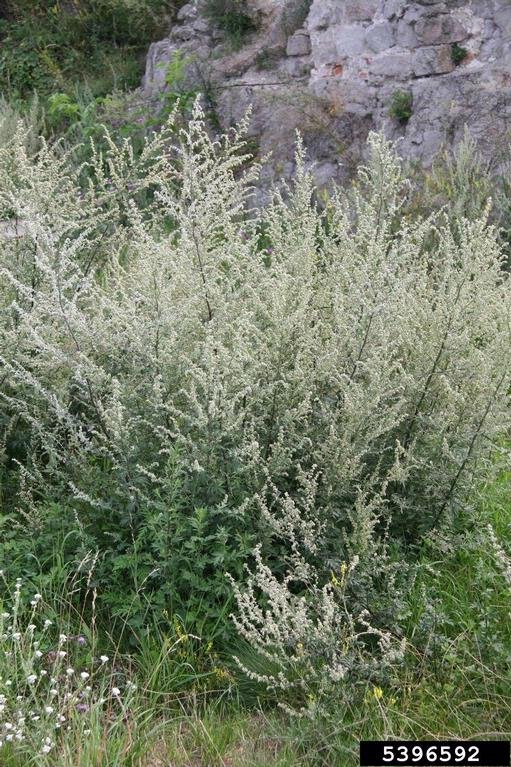
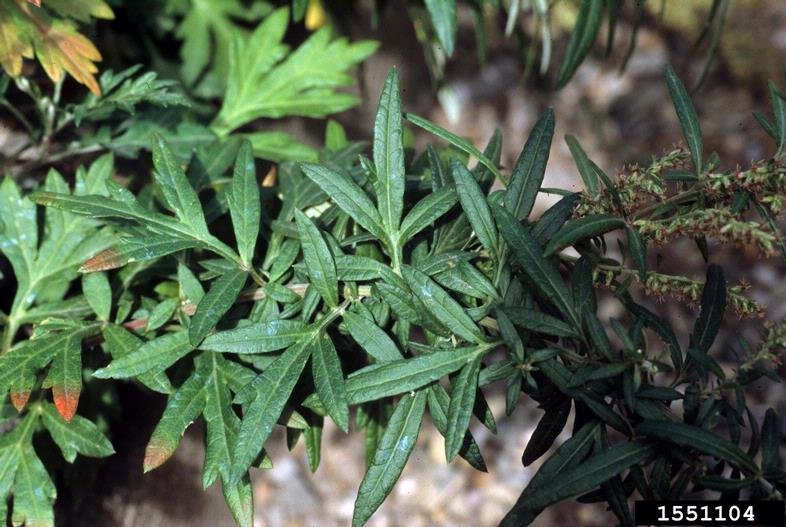
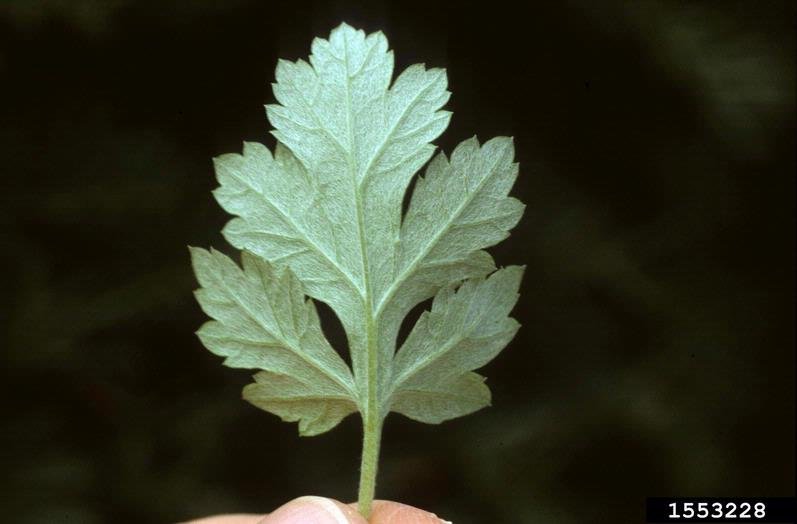
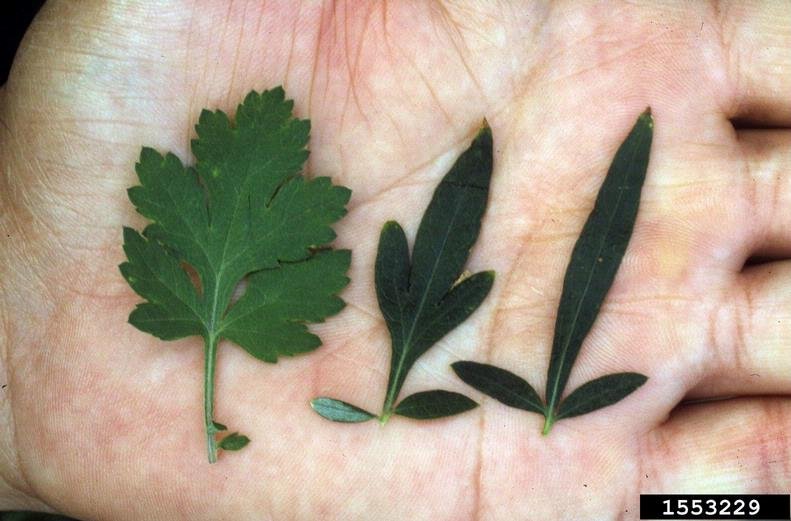
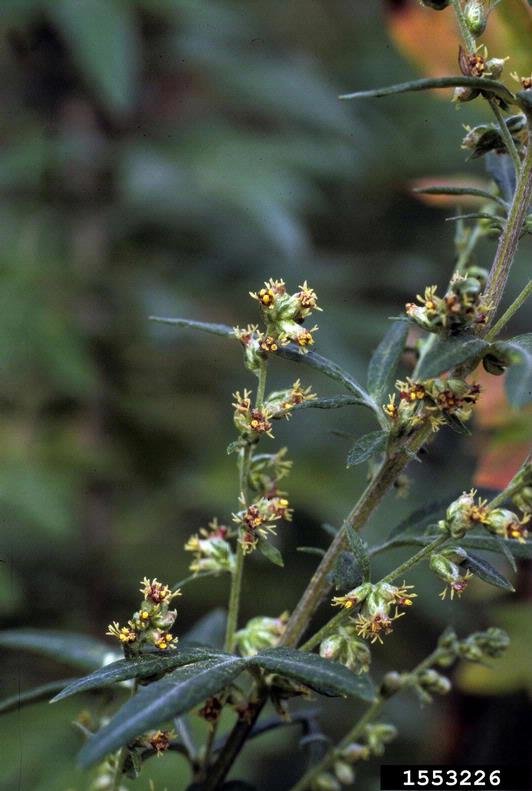
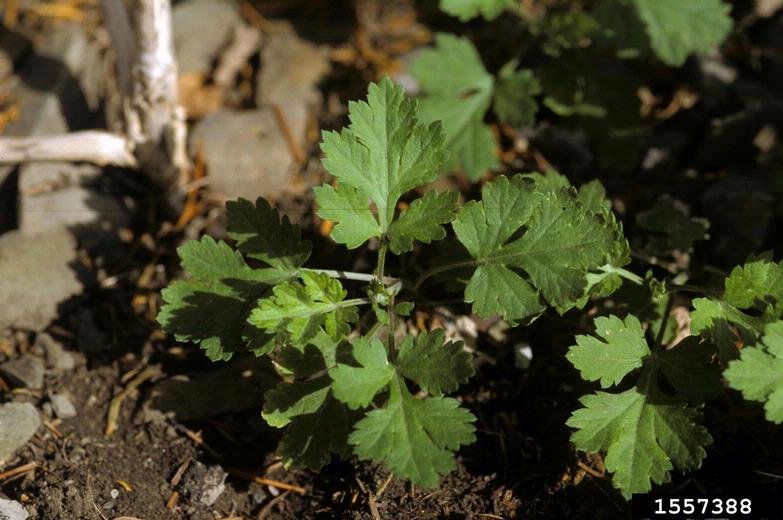
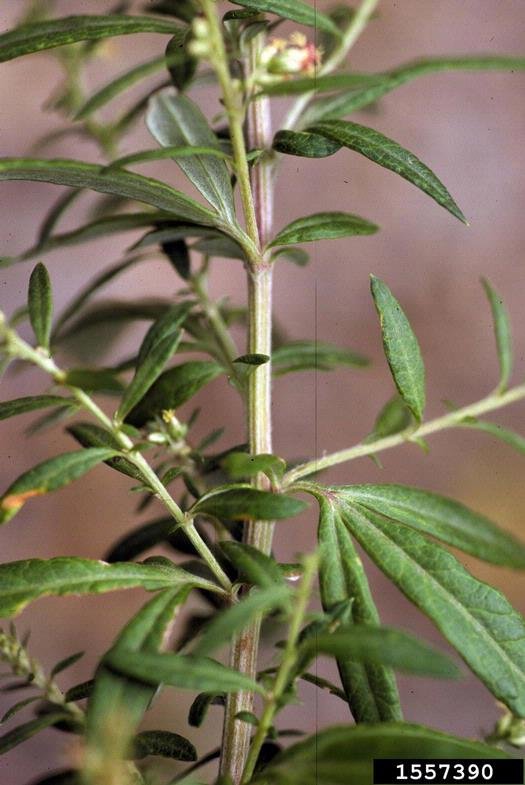
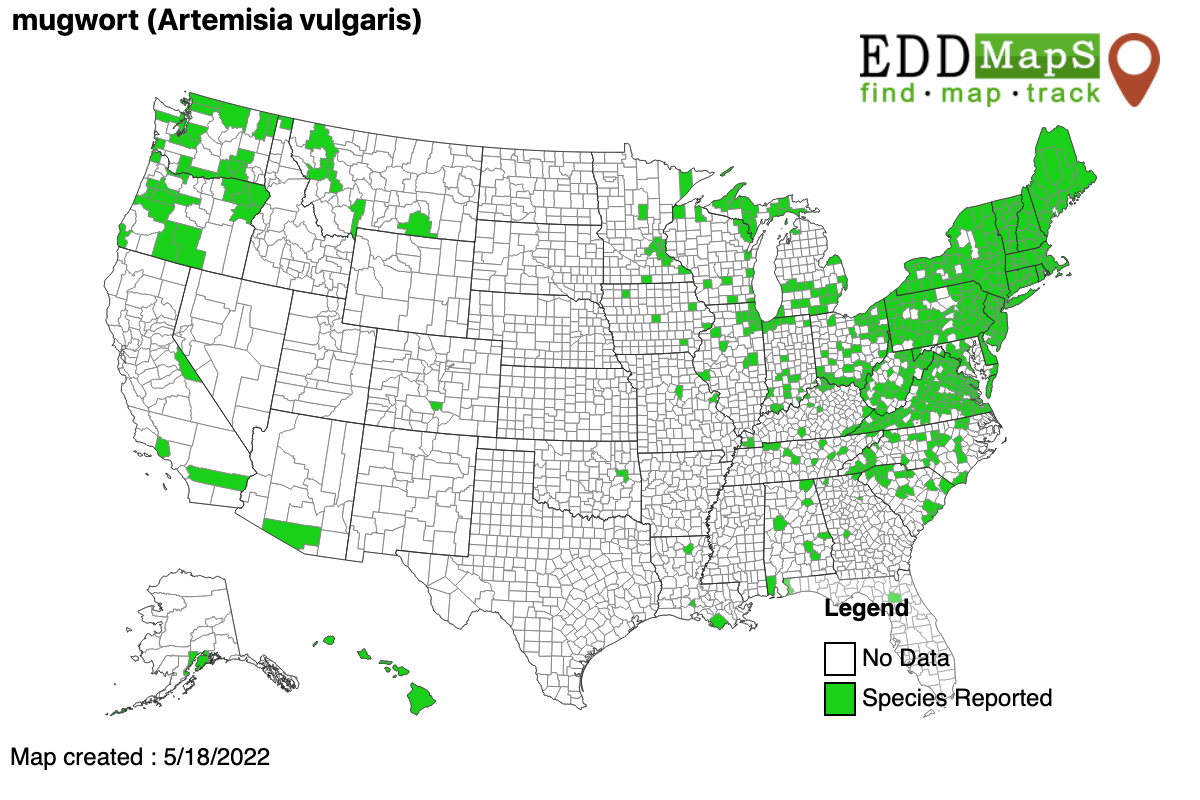
LOOK-A-LIKES: Many weedy and ornamental species have similar mature foliage, including common ragweed ( Ambrosia artemisiifolia L.) and cultivated chrysanthemums (Chrysanthemum spp.). However, both common ragweed and cultivated chrysanthemum lack the silvery-white hairs on the lower surface of the leaves.
HABITAT & DISTRIBUTION Mugwort commonly invades degraded areas such as old fields, roadsides, parking lots, forest edges and ditches, and spreads aggressively primarily by rhizomes. It is tolerant of a wide range of temperatures and conditions, with a slight preference for moist soils.
ECOLOGICAL THREAT: Mugwort is rhizomatous, and aggressively produces vegetative colonies of plants. These colonies can crowd out and displace native species, specifically those that thrive in sunny, open habitat, and can disrupt succession in natural areas. It is also allelopathic, affecting the soil chemistry and organisms, and deterring other species from growing there.
ECONOMIC THREAT: Mugwort is considered a troublesome pest in the nursery industry, due to its ability to infest nursery stock and field-grown ornamental crops (trees, shrubs, and other herbaceous ornamentals), and spreads to urban landscapes. The US nursery industry has considered mugwort to be in their top 10 most serious weeds. It has become very problematic in the eastern US, expanding beyond ornamental nurseries to pastures as well as corn, cotton, and soybean fields.
CONTROL: Since this species thrives along roadsides and areas that may be mowed, cleaning equipment can help to decrease the spread. Cutting and pulling can stimulate growth, and even a small piece of the plant can resprout, so tilling is not recommended. Using a systemic, non-selective, herbicide (ex. glyphosate) can be effective, but care must be taken to avoid desirable plants. It is most effective if applied in late summer or early fall. More selective herbicides, such as Triclopyr or clopyralid, have shown to be effective and if applied at proper rates will not harm grasses and sedges. A single herbicide application will likely not provide complete eradication, but will suppress growth for the following season. A combination of digging, pulling, mowing, and herbicide application may be most effective. Mowing is most effective in early spring and early fall, before it goes to seed. Plant matter that is dug or removed will need to be disposed of properly to ensure it doesn’t resprout.
IMPORTANT: The pesticide label is the law! When using any chemical control, always read the entire pesticide label carefully, follow all mixing and application instructions and use all personal protective gear and clothing specified. Contact the Office of Indiana State Chemist (OISC) for additional pesticide use requirements, restrictions, or recommendations.
To report an invasive species in a location where it has escaped cultivation:
Early Detection and Distribution Mapping System (EDDMapS): https://www.eddmaps.org/report/
ADDITIONAL INFORMATION AND RESOURCES:
https://weedecology.css.cornell.edu/pubs/Artemisia%20CanJPlSci.%20article.pdf
https://www.eddmaps.org/species/subject.cfm?sub=5148
https://www.invasiveplantatlas.org/subject.html?sub=5148
https://www.invasive.org/browse/subinfo.cfm?sub=5148
https://wiki.bugwood.org/Artemisia_vulgaris/NJ#Look-alikes
https://www.lhprism.org/species/artemisia-vulgaris
https://www.purdue.edu/hla/sites/yardandgarden/mugwort-wormwood-by-either-name-a-real-problem/
http://ccenassau.org/environment/invasive-plants/mugwort
https://nystateparks.blog/2018/07/12/invasive-species-spotlight-mugwort/
https://extension.wvu.edu/lawn-gardening-pests/weeds/mugwort
https://www.in.gov/dnr/rules-and-regulations/invasive-species/terrestrial-invasive-species-plants/
https://nyis.info/invasive_species/mugwort-draft/
REFERENCES:
Barney, J.N. and A. DiTommaso. 2003. The biology of Canadian weeds. 118. Artemisia vulgaris L. Canadian Journal of Plant Science 83:205-215, https://doi.org/10.4141/P01-098
Bradley, K.W. and E.S. Hagood, Jr. 2002. Evaluation of selected herbicides and rates for long-term mugwort ( Artemisia vulgaris ) control. Weed Technol. 16:164–170, https://doi.org/10.1614/0890-037X(2002)016[0164:EOSHAR]2.0.CO;2
Klingeman, William E., et al. “Regeneration of Mugwort (Artemisia Vulgaris) from Rhizome Sections in Sand, Pine Bark, and Soil Substrates.” Journal of Environmental Horticulture, vol. 22, no. 3, 2004, pp. 139–143., https://doi.org/10.24266/0738-2898-22.3.139.